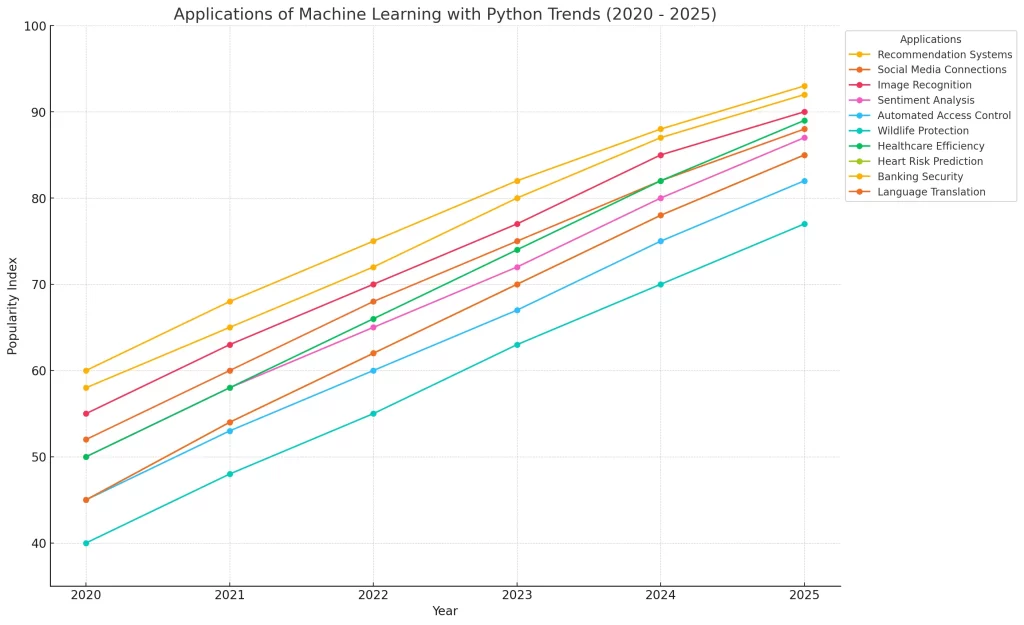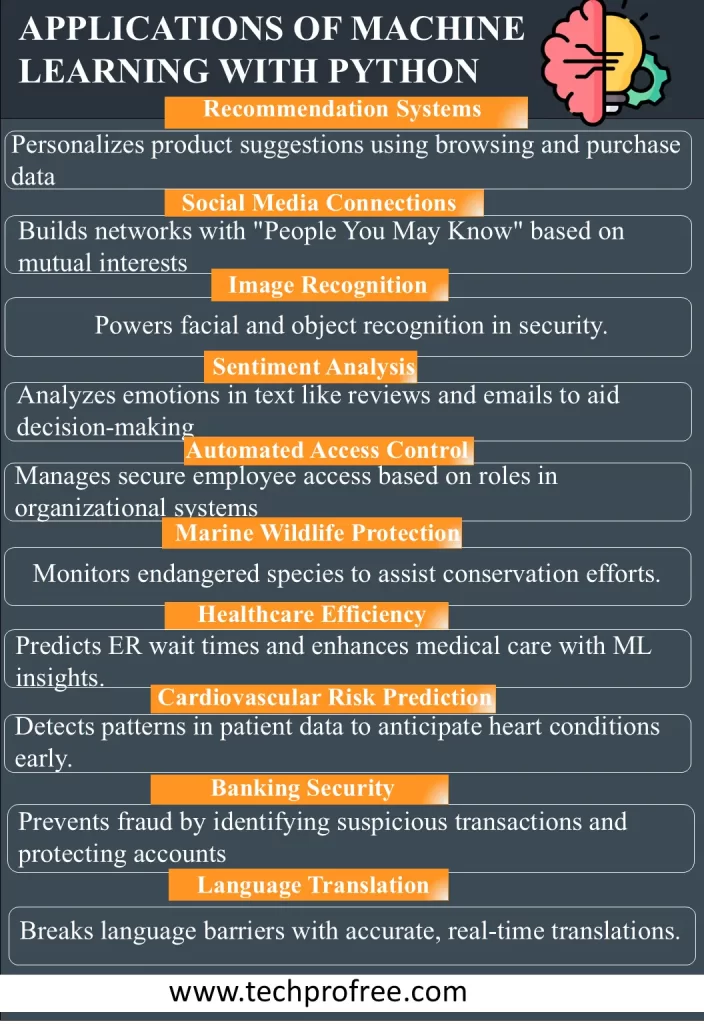Discover Real life applications of Machine Learning with Python, transforming industries from finance to healthcare with smart, Python-powered solutions. Artificial intelligence (AI) with machine learning (ML) has become the basis for advanced problem-solving across multiple industry sectors, and it is being increasingly used to bring the benefits of data-driven decision-making. Python, due to its vast libraries and easy-to-use syntax, was selected by developers as the preferred choice for the ML model development and deployment.
This discourse delves into ten compelling real-world instances showcasing the collaborative synergy between Python and machine learning, ushering in significant advancements:
Real Life Applications of Machine Learning with Python Trends from 2020 To 2024

Real Life Applications of Machine Learning with Python
Recommendation Systems
There are ML-driven recommendation engines everywhere in e-commerce platforms, so examine user behavior patterns, which may include information about users’ “browsing history”, their “previous purchases” and what they put in their shopping cart to give personalized product recommendations.
For instance, a platform such as “Spotify” or “Netflix”, similarly uses algorithms to suggest a piece of individual user music or TV shows that they presently like and have shown an inclination to the past through the application of continual learning methods.
Top 5 Real Life Recommendation Systems Application
- Amazon
- Netflix
- Spotify
- YouTube
- eBay
Social Media Connections
The tools that are responsible for “people you may know” features on social media platforms “LinkedIn”, “Instagram” and “Facebook” leverage “ML” methods to bring up possible associations based on an increase in clicks, connections and mutual friendships, thereby broadening the networks.
Top 5 Real Life Social Media Connections Application
- Snapchat
Image Recognition
ML image recognition systems are the major driving factors for the development of applications like facial recognition for authentication mechanisms like “Face ID” for the law enforcement agencies. Through the examination of pixel contrasts, these systems can recognize one or several objects, or identify a person within an image. Ultimately, this can help to resolve a case by comparing the face to a database of suspects.
Sentiment Analysis
Sentiment analysis is a very important application of the machine learning area in which they can classify in real time the current emotional tone or opinion of the speakers or writers. Through a fast analysis of text content like “reviews”, “emails” and any other documents, sentiment analysis tools, help to find the exact sentiment and hence, find their use in review “websites” and in “decision-making” applications.
Automating Employee Access Control
Endeavors are progressively utilizing AI calculations to mechanize the assignment of access honors to workers in light of their particular work jobs. This application represents the consistent coordination of AI into authoritative “security structures” and “streamlining access” to the executive’s processes.
Marine Natural Life Protection
AI calculations add to the protection of marine natural life by creating conduct models for put-in-danger species like cetaceans. These models help researchers in observing and controlling population elements, subsequently cultivating protection actions.
Managing Medical Services Proficiency and Clinical Benefits
In medical services, ML upgrades functional productivity by foreseeing patient holding up times in crisis divisions in light of elements, for example, “staffing levels”, “patient records” and “office designs”. Also, aids in “infection position”, “treatment ordering” and predicting, in this way enlarging medical care administration conveyance.
Foreseeing Potential Cardiovascular breakdown
Upsetting clinical findings, ML dissects freestyle doctor notes and patient cardiovascular accounts to distinguish designs demonstrative of potential cardiovascular breakdown. This approach clears and straightens out demonstrative cycles, decreasing obvious repetitiveness and empowering ideal mediation.
Banking Area
Monetary establishments use ML to battle extortion and support account security by making channels/ways that recognize doubtful exchanges and unapproved movements. Such calculations upgrade the “validation interaction”, shielding accounts from expected dangers.
Language Interpretation
Machine learning powers language interpretation gadgets, working with consistent interpretation between various languages while protecting pertinent significance. This innovation, known as machine interpretation, cultivates “worldwide” correspondence by separating language obstructions, enabling people to communicate across phonetic partitions easily and with certainty.

Conclusion
This investigation of ten genuine applications has revealed insight into the strong cooperative relationship between Python and ML. Their cooperative power is driving progressions across assorted fields, from change and money to medical care and logical examination. This article fills in as a springboard for additional investigation. Each of these applications can be delved into deeper, showcasing the intricate details and technical aspects involved. Additionally, the potential for future applications is vast, considering the continuous evolution of both “Python” and “machine learning”. As these technologies mature, we can expect even more groundbreaking innovations that will redefine how we interact with the world and solve complex challenges.



Leave a Comment